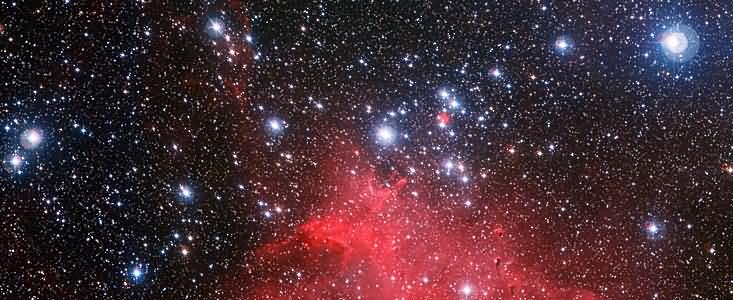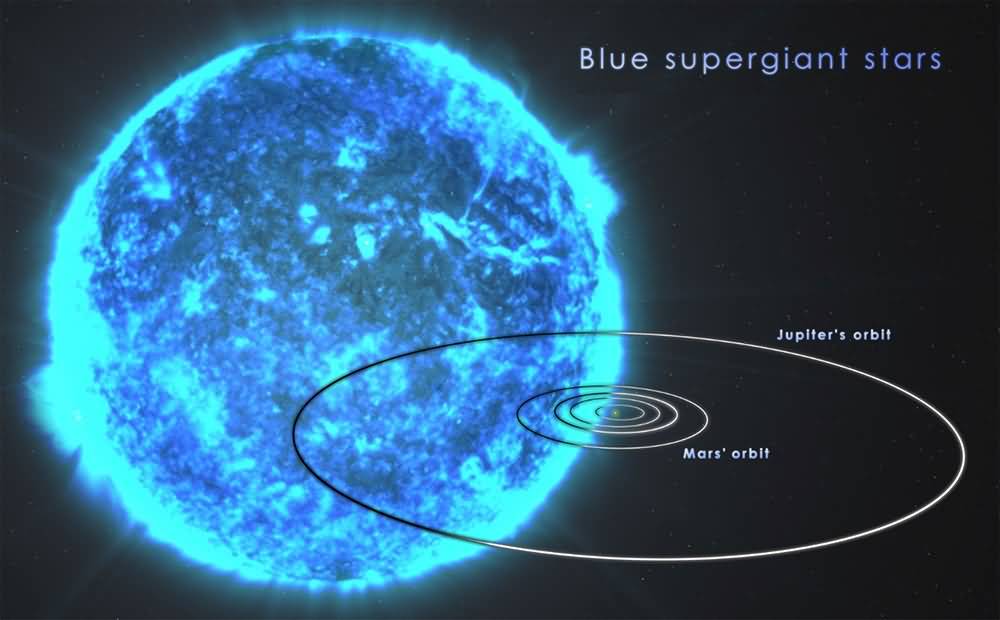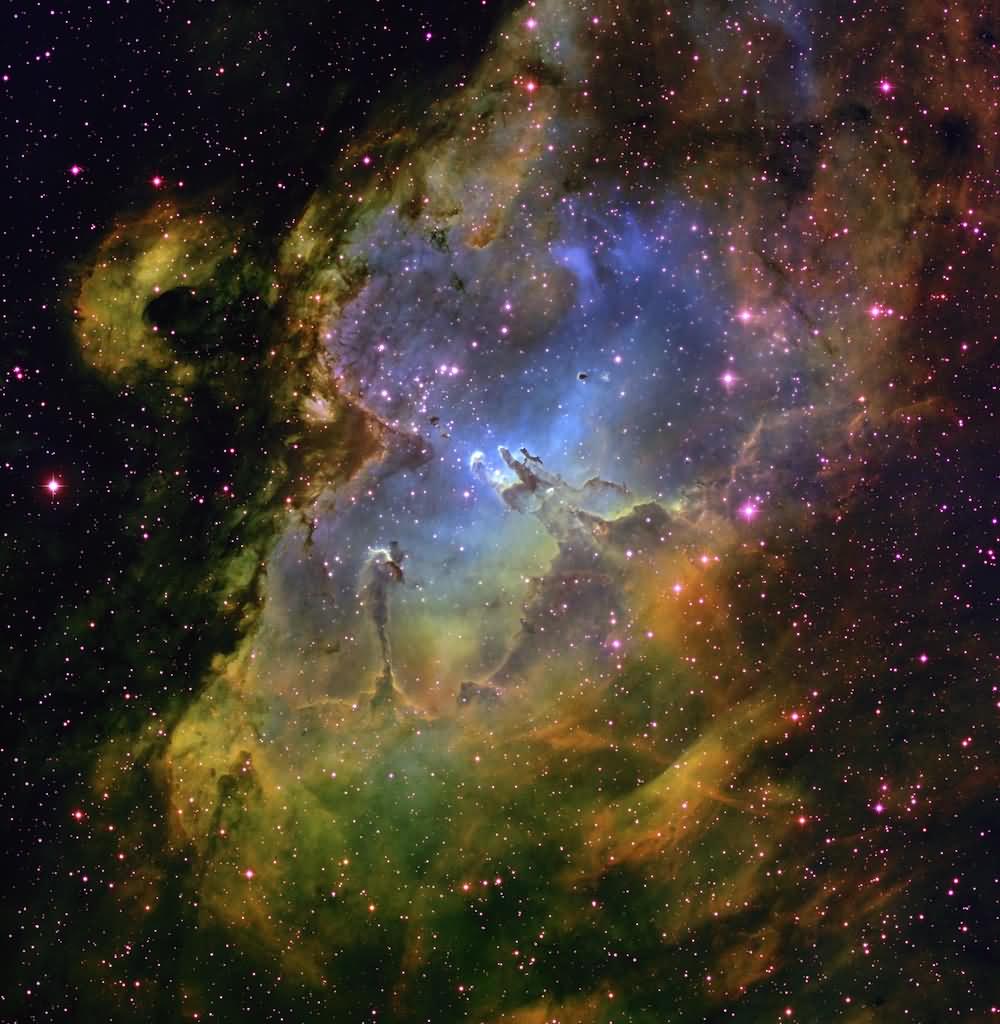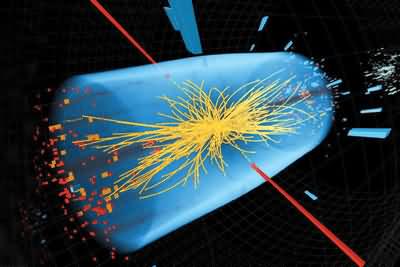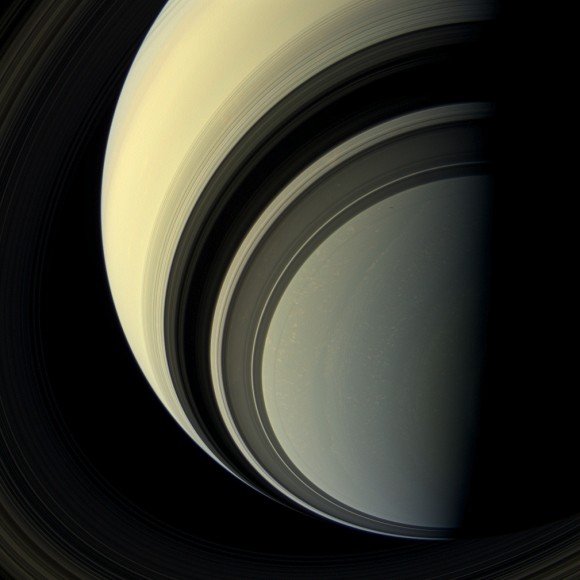Stunning Scenes from Young Stars
ESO astronomers have obtained the best images yet of the strange clouds around the star cluster NGC 3572. The new images show how these clouds of gas and dust have strange bubbles, arcs, and unusual features known as elephant trunks, caused by stellar winds expelled from hot young stars.
Most stars don't form singly; many stars can form from a single cloud of gas and dust at roughly the same time. NGC 3572, located in the southern constellation The Spine, is one such cluster. It contains a large number of hot, young, blue-white, brightly glowing stars that generate powerful stellar winds, prone to blowing debris and dust around them into space. The glowing clouds of gas and their accompanying star clusters are the highlights of this new image taken with the Wide Field Imager on the MPG/ESO 2.2-metre telescope at ESO's La Silla Observatory in Chile. [1].
At the bottom of the image, a large patch of molecular cloud is still visible, providing a source of new stars. It is dramatically affected by the powerful radiation from these newly formed stars. This radiation not only causes the clouds to glow a distinctive color but also causes them to form into beautiful spiral shapes, including bubbles, arcs, and the dark columns astronomers call elephant trunks. [2].
One interesting feature captured in this image is a tiny ring-like nebula just above the central portion. Astronomers are still unsure of the origin of this small, unusual feature. It is most likely a dense remnant of the molecular cloud that formed the cluster, perhaps a bubble around a very hot, bright star. However, some astronomers think it could be some kind of oddly shaped planetary nebula—the remains of a dying star. [3].
Stars born within a cluster may be siblings, but they are not twins. They are nearly the same age, but differ in size, mass, temperature, and color. A star's lifespan is largely determined by its mass, so stars at different stages of their lives within any given cluster provide excellent laboratories for astronomers trying to understand how they evolved. [4].
These star clusters can typically coalesce over relatively short periods of time, typically tens or hundreds of millions of years. Gravitational interactions gradually disperse them, but the short-lived, massive stars often exhaust their fuel and end their lives in violent supernova explosions, contributing to the disintegration of the remaining gas and stars in the cluster.
Notes
[1] The data used to create this image was obtained by a research team led by ESO astronomer Giacomo Beccari. The team used the power of the Wide Field Imager to investigate the physics of the planetary disks of young stars in NGC 3572. They were surprised to encounter stars in the cluster that were over ten million years old and clearly still accreting, meaning they should be surrounded by stellar disks. This suggests that star formation in NGC 3572 has been ongoing for at least 10-20 million years, making planet formation a longer timescale than previously thought.
[2] The most famous example of such elephant trunks is the Pillars of Creation in the Eagle Nebula, precisely imaged by the NASA/ESA Hubble Space Telescope (http://www.spacetelescope.org/images/opo9544a/).
[3] When a Sun-like star uses all its fuel, it sheds its outer parts into the surrounding space. The hot remnants of the star continue to shine through this material, creating beautiful but short-lived sheets of glowing ionized gas called planetary nebulae. This historical designation refers only to the appearance of these objects in a small telescope; they have no physical connection to a planet.
[4] A star's lifetime depends on how massive it is. A star fifty times more massive than the Sun may only live a few million years, while the Sun may live up to about 10 billion years, while a low-mass red giant star may live for trillions of years—much longer than the present age of the Universe.
More information
ESO, the European Southern Observatory, is the most important intergovernmental astronomy organization in Europe and the most productive astronomical observatory in the world. It is supported by 15 countries: Austria, Belgium, Brazil, the Czech Republic, Denmark, Finland, France, Germany, Italy, the Netherlands, Portugal, Spain, Sweden, Switzerland, and the United Kingdom. It operates an ambitious program focused on the design, construction, and implementation of robust ground-based observations that enable important scientific discoveries. ESO also plays a leading role in promoting and organizing astronomical research. ESO operates three unique, world-class observing sites in the Atacama Desert of Chile: La Silla, Paranal, and Chajnantor. At Paranal, ESO operates the Very Large Telescope (VLT), the world's most advanced optical astronomical observatory, and two survey telescopes. The infrared telescope, VISTA, is the world's largest survey telescope, and the VLT survey telescope (VST), the world's largest telescope designed to scan the sky in visible light only. ESO is the European partner of ALMA, the largest existing astronomical project and the revolutionary astronomical telescope. ESO is currently planning to build the European Extremely Large Optical/Near-Infrared Telescope, E-ELT, with a mirror diameter of 39 metres, which will be "the world's largest eye on the sky."
ESO Press Releases are translated by science community experts and science communicators from ESO member countries and other countries within the ESO Science Community Network (ESON). The ESON Turkey translation team includes experts from Ankara University (Ankara), Çağ University (Mersin), Başkent University (Ankara), Istanbul University (Istanbul), Izmir University of Technology (Izmir), and the Max Planck Institute for Extraterrestrial Physics (Germany).
Connections
- Return of the 2.2-meter telescope
- Images taken with the MPG/ESO 2.2-metre telescope
- Images from the MPG/ESO 2.2-metre telescope
- ESO press releases on data taken with the MPG/ESO 2.2-metre telescope

